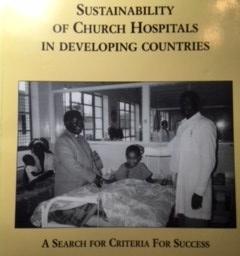A little publication in 1998 surveyed 43 church-related mission hospitals to identify criteria for sustainability. They identified nine critical success factors in the process:
- Vision/mission/objectives. These hospitals had a Christ-centered vision that had been translated into ‘do-able’ mission statements and behavioral objectives to guide board and staff members at all levels in their day to day work. They were actively revisited at induction training sessions, retreats and other meetings.
- Visionary governance. There was appropriate representation of various stakeholders, availability of the range of expertise needed, and availability of the experience required to set up policy guidelines to help the institution in business dealings, etc.
- Dynamic technical and managerial leadership. Careful selection of managers and supervisors was reinforced by training, nurtured by prayer, and tested on a continuing basis by application at work. The board showed active interest and demanded accountability at reasonable and regular intervals. These leaders, in their daily interaction with people at all levels and all classes of society, demonstrated commitment to Christian values and determination to live them in words and actions. (Hurrah!)
- Reputation for quality of care. These hospitals had a long standing reputation for excellent care in their particular areas of expertise. In many cases this reputation was built by missionary doctors and related staff many decades ago but had been maintained by successors, and continues to serve as a magnet and beacon for patients. This boosted outpatient visits to an optimum of about 150 per day and filled beds to at least 60 percent capacity; this in itself appears to enhance survival.
- Adequate quantity, quality and stability of staff. These hospitals had adequate numbers of well-trained staff, especially in the strongest specialties. This generated patient confidence. Innovative strategies to reward and retain staff appear very important. Ensuring local access to quality education for staff children was also vital.
- Solid financing and financial administration. Key characteristics of the ‘successful’ hospitals were the capacity to generate good revenue, atract local funds and external donations and grants, disburse them wisely, and account for them consistently with generally accepted financial practices. This earned them confidence with stakeholders, patients, governments and donors.
- Viable location. Some were in urban areas and able to have clientele who earned money, and others were in rural areas where local people lived near active markets, making incomes reasonable to sustain the hospitals and still serve those who were not able to pay.
- Church commitment to health ministry. Possibilities of sustainability were greatly enhanced in situations where churches had inherited hospitals from missionaries but had made firm commitments to to operate them, drawn up clear policies and made it a priority to provide for them financially and materially. Such churches expected to be net contributors to the hospitals, seeing them as part of their Christian outreach or mission. Churches which viewed ‘their’ hospitals as a source of income, taking money out of them whenever possible, tended to be less successful.
- Government policies conducive toward private providers. Sustainability was improved when governments made provision for selected para-pubic institutions such as church hospitals to be integrated into the national health network of services, while leaving the churches free to make their own capital development and administrative policies. In these situations, the governments made substantial recurrent-cost contributions to the hospitals concerned, thereby decreasing their running costs and making them more viable.
In planning for successful handover from foreign (or mission) ownership to local, these success criteria can give us a helpful roadmap. Although one may not be able to do much about changing the location of a hospital, plans can develop leadership for many other aspects, such as:
- Maintaining a Christ-centered vision for ministry
- Careful attention and planning for good governance
- Development of leadership both on the technical managerial side as well as the clinical side of services
- Planning for staff development, including attention to all of life (relational, spiritual and family — even education of children!)
- Solid financial systems and accountability
- Developing church leadership which knows Scripture well and can embrace ministry of Word and deed, without neglecting either one. (For centuries the church has been active in giving sacrifically to serve the poor).
- Advocating with government on policy or larger country-wide issues, especially when it comes to caring for the marginalized and brokenhearted — see Isaiah 61:1)
